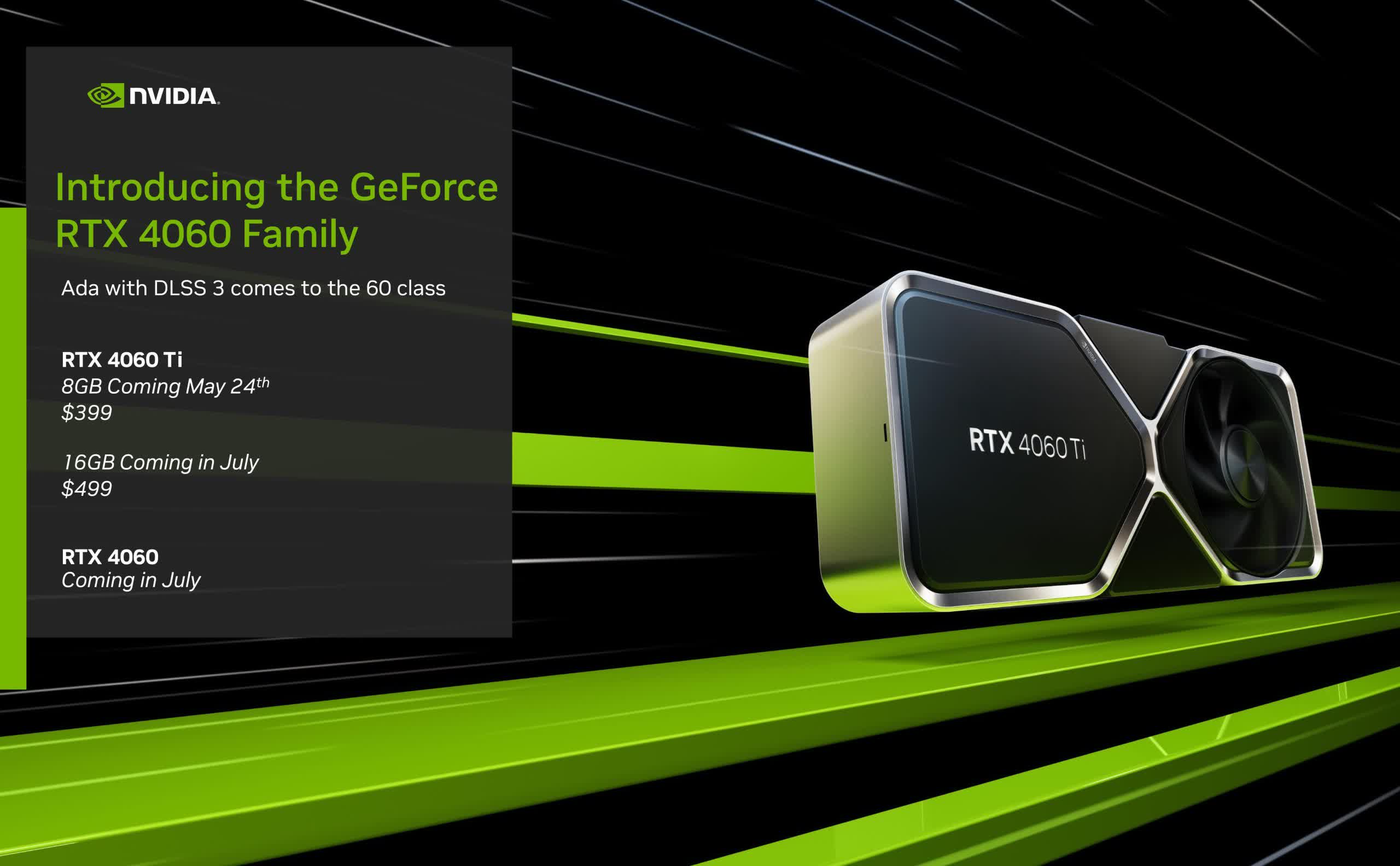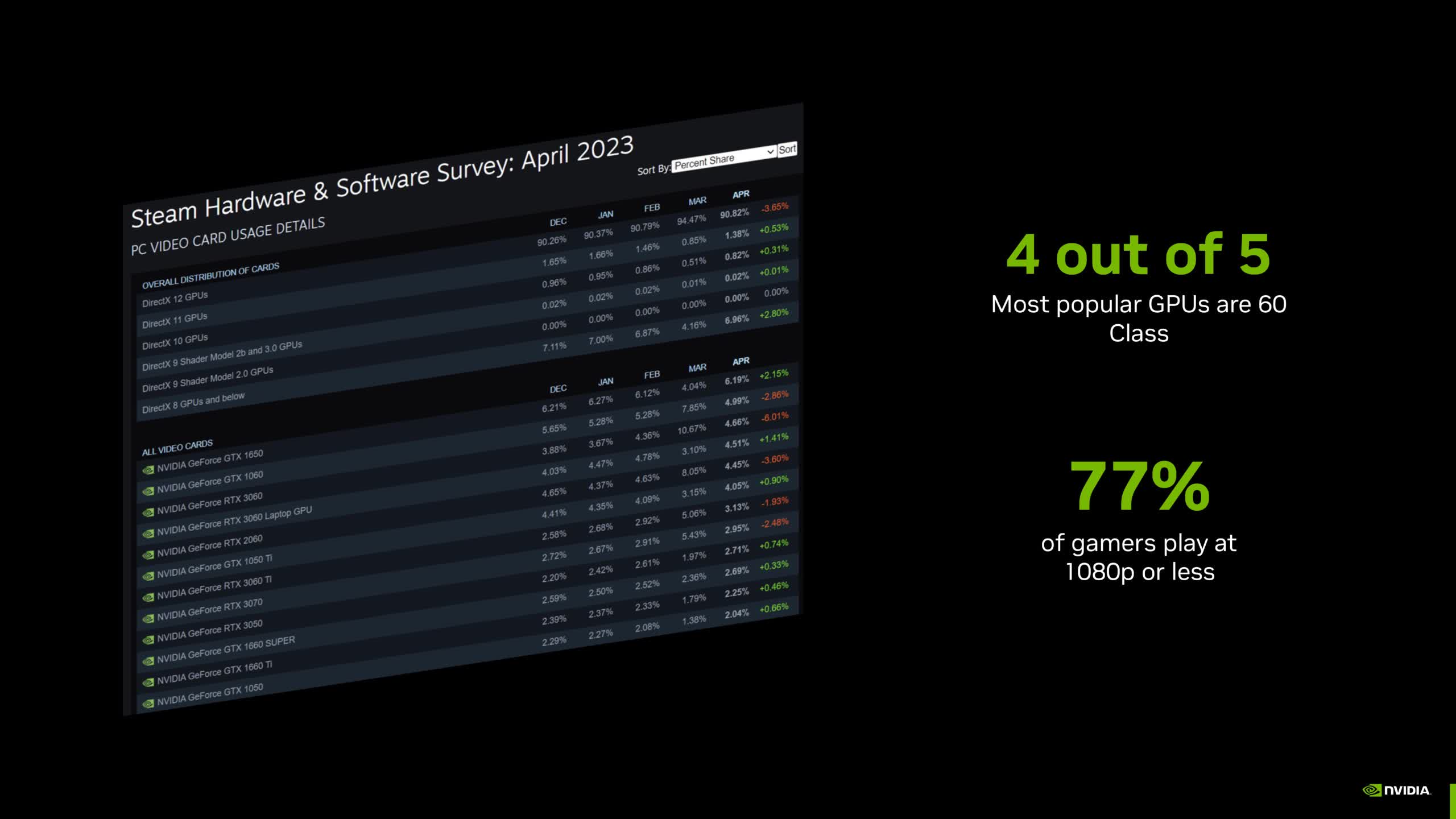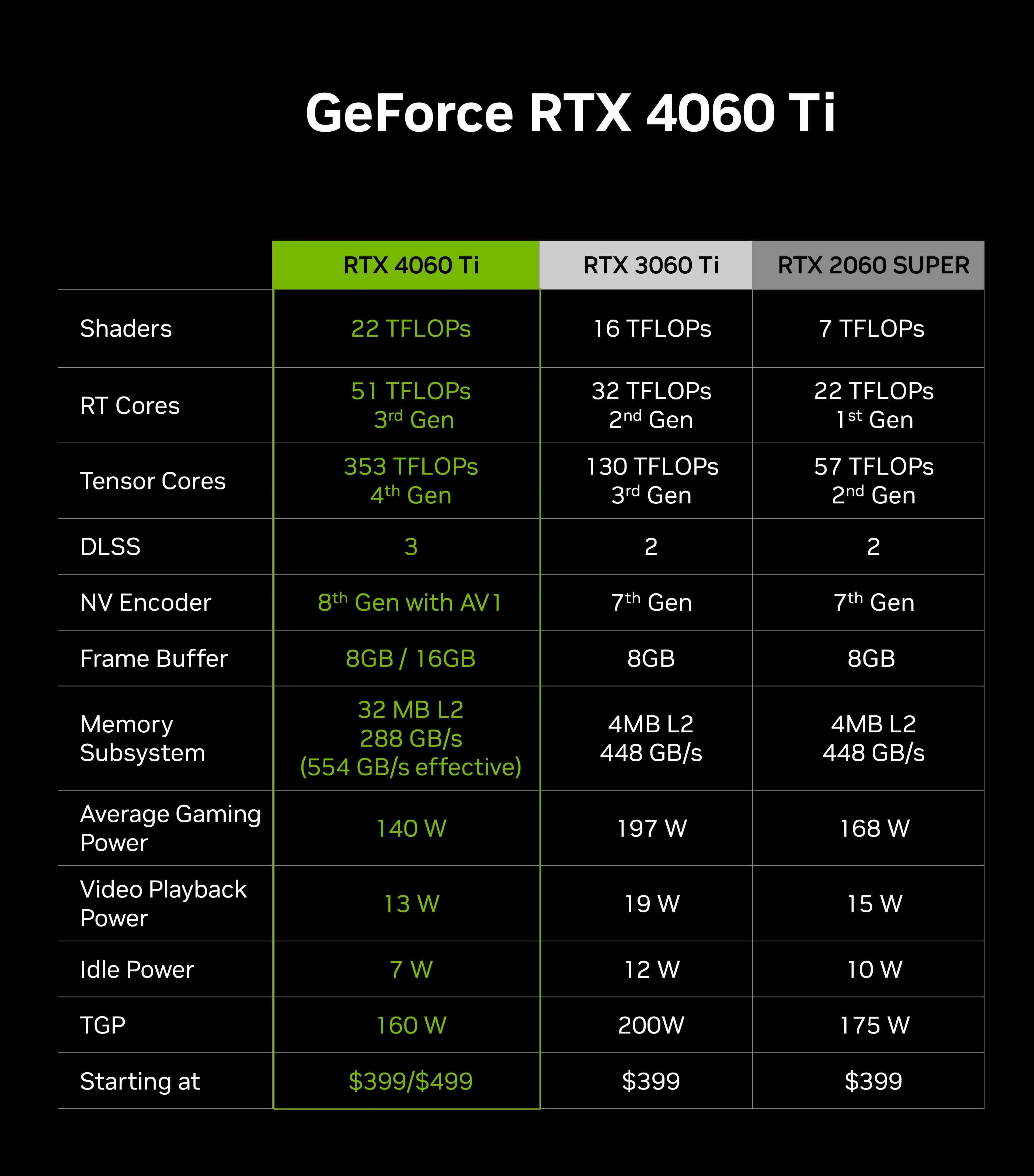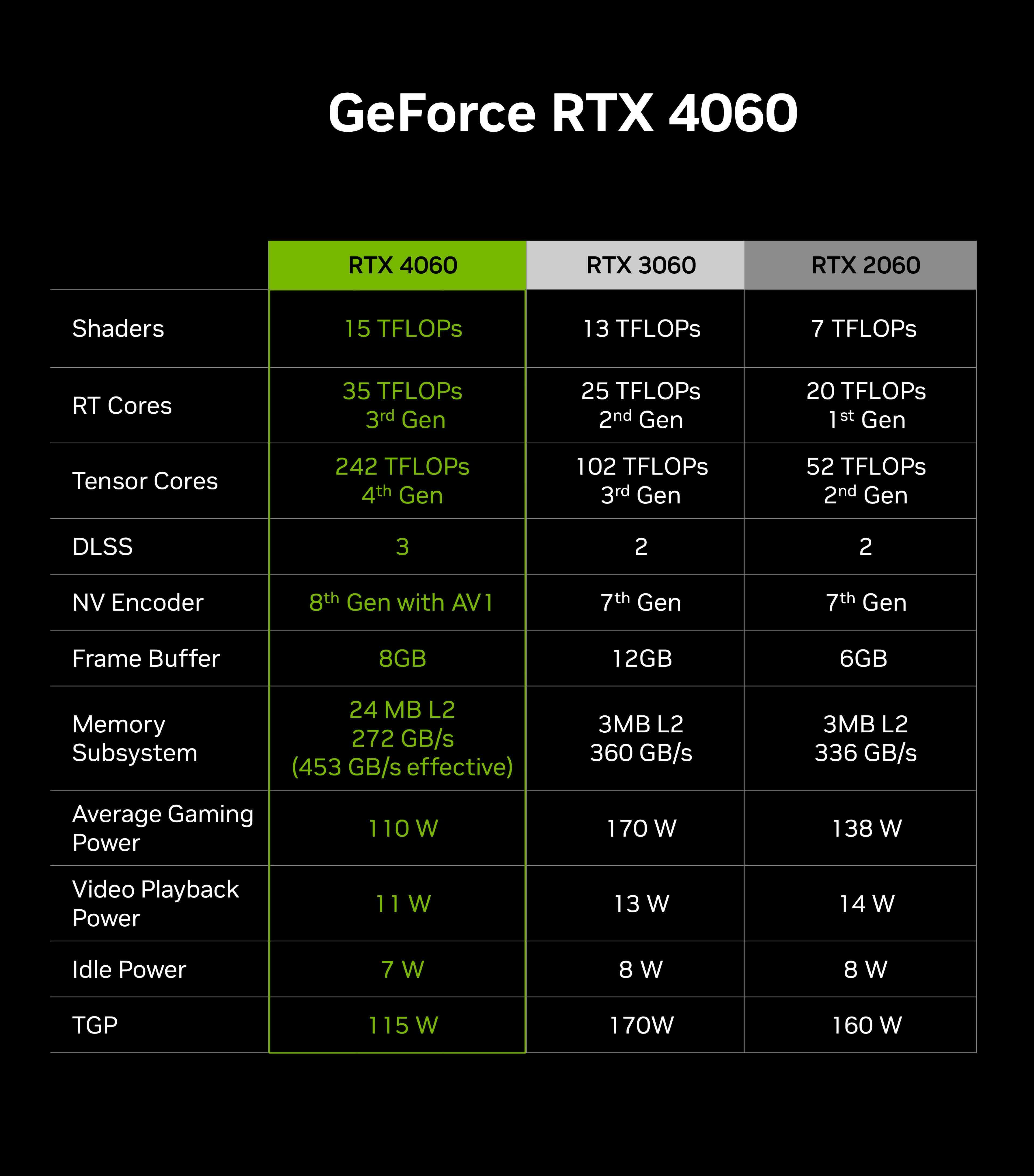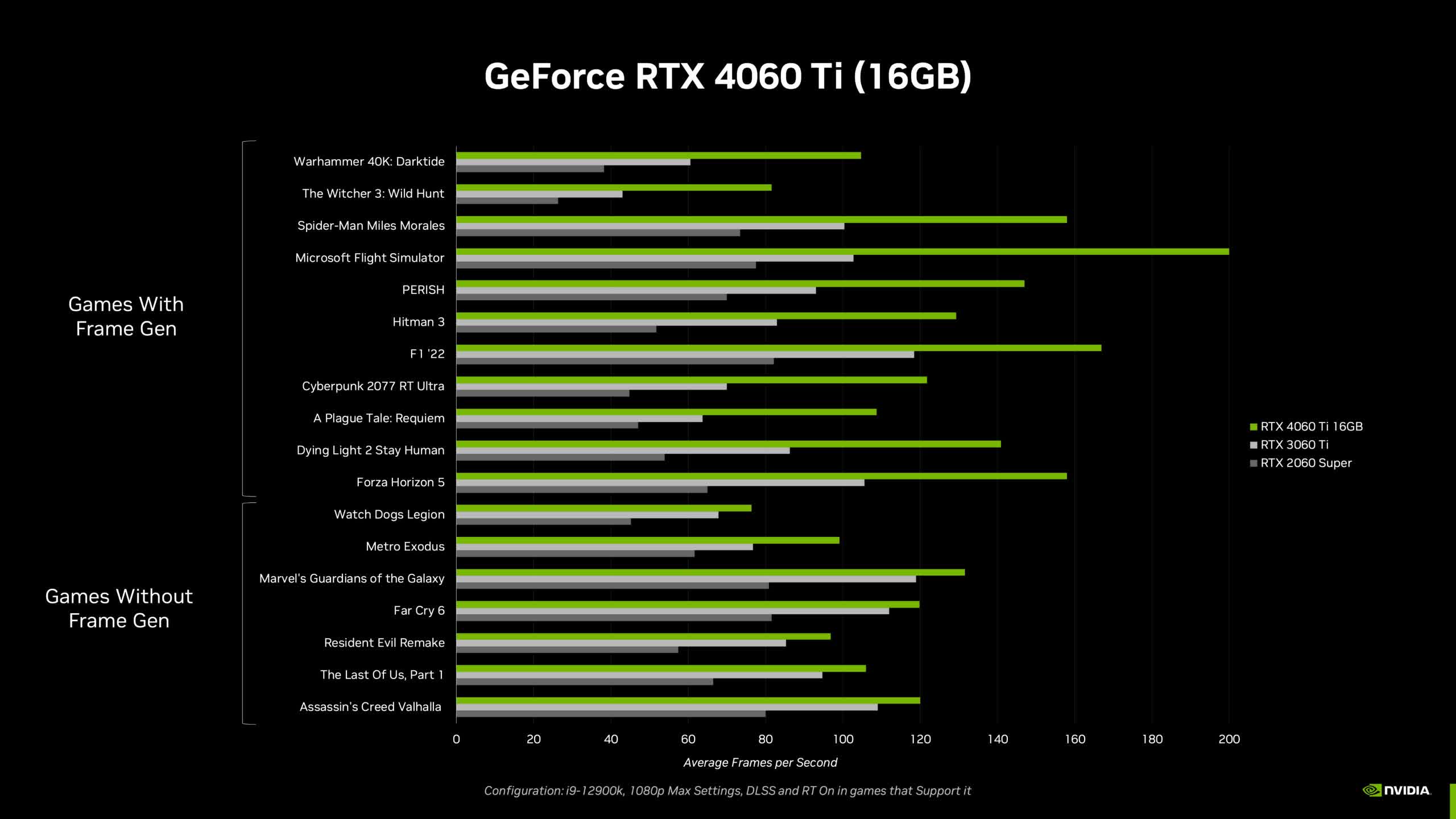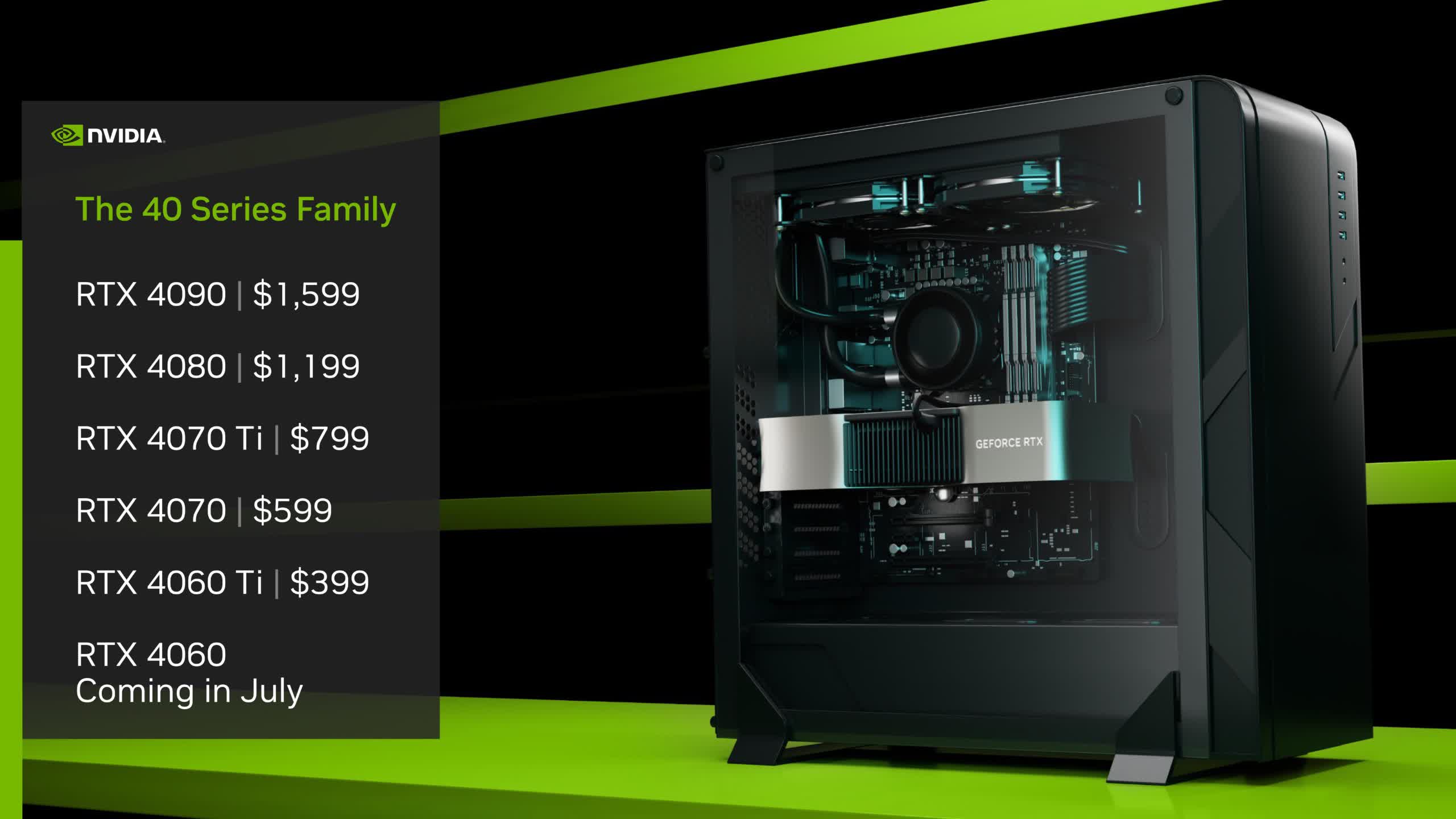Highly anticipated: Nvidia is announcing three new graphics cards as part of their GeForce RTX 4060 series: the RTX 4060 Ti 16GB, the RTX 4060 Ti 8GB, and the RTX 4060 (non-Ti model). We have specifications, pricing, and release date information for these three cards, along with some first-party performance estimates to discuss, all wrapped up in our usual analysis. So let's talk about these new GPUs.
First, the information that most people will be interested in: when you can buy these cards and how much they will cost. Coming first, on May 24th, is the RTX 4060 Ti with 8GB of VRAM; in just under a week, you'll be able to buy one for $399, which is the same price as the RTX 3060 Ti it's replacing. This makes the 4060 Ti the first card that, tier for tier, does not increase the price compared to the previous generation model.
Coming later in July is a higher capacity variant of the RTX 4060 Ti with 16GB of VRAM, priced at $500. This is a hefty premium to pay for an extra 8GB of VRAM, especially since Nvidia told us this product has the same GPU die configuration as the 8GB model. In the past, Nvidia has tinkered with the core count and other hardware when producing two models of differing memory capacities, typically giving the higher VRAM model more shader cores. But this isn't the case here; this is simply a $500 RTX 4060 Ti with double the VRAM.
Also coming in July is the RTX 4060, the non-Ti model. This card will be priced at $300 – quite a surprising price, if we're honest, given that the RTX 3060 was priced slightly higher at $330. However, the RTX 4060 does feature less VRAM, just 8GB compared to 12GB on the previous-gen model, so we're sure this has played into the pricing decision there.
For specifications, Nvidia has yet to release the full table of core configurations and so on, but we do have some information to go on. The RTX 4060 Ti uses the Ada Lovelace architecture and is built on TSMC's 4N node; we're expecting this to be an AD106 die, a downgrade from the GA104 die used in the RTX 3060 Ti in terms of size and class, but this hasn't been officially confirmed yet. What we do know is that there's 22 TFLOPs of shader performance, 51 TFLOPs of RT performance, and 353 TFLOPs of tensor performance – this implies a core configuration with 34 SMs and 4352 shader units, at similar clocks to other RTX 40 series GPUs.
The memory bus has been substantially reduced compared to the RTX 3060 Ti, dropping from 256-bit to 128-bit, although GDDR6 speeds have increased from 14 to 18 Gbps, resulting in 288 GB/s of bandwidth. Given this significant decrease in memory capabilities, Nvidia is now including a "554 GB/s effective" memory bandwidth figure, which factors in the L2 cache performance, which is much larger at 32 MB on this GPU. Whether or not this small L2 cache can compensate for the much lower GDDR6 memory bandwidth for games remains to be seen, and it is certainly something to test against the 3060 Ti.
As this card uses a new architecture on a new node, it features reduced power consumption, dropping the TGP from 200W to 160W, and Nvidia expects an even larger discrepancy in "average gaming power." The architecture upgrade also supports new features such as AV1 encoding capabilities and DLSS 3 frame generation.
With these specifications, the RTX 4060 Ti will have approximately 75% of the RTX 4070's core configuration, but only 57% of the memory performance and 66% of the VRAM. This is a much more significant reduction compared to the RTX 3060 Ti vs. RTX 3070, as both of these RTX 30 series GPUs used the same die and had the same memory capabilities, while the 3060 Ti had 83% of the SMs. What this means is we can expect a larger gap between the 4060 Ti and 4070 than we saw between the 3060 Ti and 3070.
The RTX 4060 is cut down even further. This is still an Ada Lovelace product built on TSMC 4N, but we're expecting the use of the AD107 die here. With 15 TFLOPs of shader performance at similar clock speeds to other RTX 40 series GPUs, it implies 24 SMs and 3072 shader units – just 71% of what buyers get from the RTX 4060 Ti. However, the memory subsystem is less affected, with 8GB of GDDR6 on a 128-bit bus delivering 272 GB/s of bandwidth, using 17 Gbps memory. This is still a downgrade compared to the RTX 3060, which not only offered more memory bandwidth due to its 192-bit bus but also a higher capacity in the more widely available 12GB configuration.
What's perhaps most impressive here, though, is a TGP of just 115W, making this a very efficient GPU with the possibility of small, compact designs. This isn't a huge surprise given the expected use of AD107, with the 107 die previously being used for products like the RTX 3050 (in some cases) that also had low power consumption. The new architecture also provides features like AV1 encoding and DLSS 3 frame generation.
With the main details of these products covered, there is a clear elephant in the room: the low memory capacity of two of these GPUs, at least. The RTX 4060 Ti with just 8GB of VRAM priced at a whopping $400 seems quite problematic, given the increasing number of games that struggle to run using ultra settings on 8GB cards. As we've shown in many examples, this is a clear trend for modern games, which may relegate the RTX 4060 Ti to only being usable on medium-ish quality settings depending on the title.
Nvidia stated in their briefing with us that the RTX 4060 Ti isn't designed to be used on ultra settings; being a mid-range card, it's more suited to high-ish settings at modest resolutions. Indeed, many games will run fine on an 8GB card in the short term with dialed-down texture quality. The issue is that VRAM capacity will likely be the only reason full ultra setting gaming will be unachievable (especially with ray tracing enabled), as the core GPU performance of this product is otherwise capable of ultra settings.
In effect, this card is similar to an RTX 3070 in terms of performance, and we already know from our previous investigations that an RTX 3070 is quite capable of ultra settings gameplay when provided with enough VRAM. We strongly suspect the 8GB RTX 4060 Ti will face similar limitations as the RTX 3070.
It will likely become apparent when the 16GB model becomes available in July. Although it costs an exorbitant $100 more to get double the VRAM, this card will almost certainly not have the same limitations as the 8GB model, and many games that aren't playable on ultra settings on the 8GB card will be very playable on the 16GB card, despite otherwise identical GPU core hardware. This puts Nvidia in a difficult position, where they're trying to claim the RTX 4060 Ti 8GB card will not have any limitations for gamers using realistic settings while also claiming the 16GB model gives gamers an advantage worth paying an extra $100 for. It seems unlikely that both claims can be true.
At the end of the day, it's going to be difficult to recommend gamers spend $400 on a card with just 8GB of VRAM, given the trends we are seeing in modern games. Based on this hardware spec alone, the card feels a bit dead on arrival. Maybe Nvidia will be able to pull off a miracle and make this the best-ever 8GB GPU. We'll have to wait and see in our testing. But our initial impressions are that the RTX 4060 Ti should only have one model, the 16GB model, priced at $400.
The RTX 4060 is also in a spot of bother when it comes to VRAM capacity, although to a lesser degree than the 4060 Ti due to its lower price tag and lesser performance. Still, at $300, it could be hard to recommend a product that may have obvious limitations on launch day due to insufficient VRAM, especially in comparison to its predecessor, the RTX 3060, which launched with 12GB of VRAM. In the most VRAM demanding games using ultra settings, like The Last of Us Part I, for example, the RTX 3060 may end up outperforming the newer 4060 due to its larger VRAM buffer.
For a card like the RTX 4060, it will depend on its overall performance. If the GPU otherwise couldn't play the latest titles using ultra quality settings at playable frame rates, it's less important if that GPU also can't use ultra textures due to VRAM limitations. But if it ends up being the case where VRAM is the only limitation, it will also be difficult to recommend, and we think that 8GB of VRAM is not sufficient for a $300 product in 2023.
Nvidia's performance claims for these products are a mixed bag as well. Let's look at what they are saying for the RTX 4060 Ti, the 8GB model. Compared to the RTX 3060 Ti, Nvidia claims a 15% performance uplift in titles without frame generation, which gives us an idea of the raw performance difference between these models.
A 15% performance improvement at 1080p at the same price compared to the previous generation is not a particularly impressive gain. It seems clear that Nvidia will be using DLSS 3 as the key selling point here, which is not accessible on Ampere GPUs. Nvidia claims a 60% performance uplift over the RTX 2060 Super, which is probably enough to begin enticing Turing users to upgrade, but it's questionable whether anyone still waiting to upgrade would change their mind based on only a 15% uplift in performance over a card already on the market at the same price.
RTX 2060 Super owners have had ample opportunities to buy an RTX 3060 Ti for around $400 over the last few months; if they wanted that level of performance, they would have bought that card already. Is a card 15% better going to sway opinion and entice those people to upgrade? It's questionable whether that's enough of an uplift.
On the other hand, the RTX 4060 Ti should deliver around the performance of the RTX 3070 at a $100 discount compared to the previous generation, at least looking at the 8GB model. Our testing puts the 3070 roughly 15% ahead of the 3060 Ti, which is the same margin Nvidia is touting here. That's certainly a more positive way of looking at things, but with the VRAM limitations of the RTX 3070, a $100 discount may not be enough.
This also puts the RTX 4060 Ti 16GB model in a difficult position. As it has the same core configuration as the 8GB card, the 4060 Ti 16GB should end up with roughly the same performance as the RTX 3070 at the same price – with the benefit being fewer limitations in VRAM-heavy games due to its higher VRAM capacity. That's a nice bonus to have, but again it's questionable whether that sort of upgrade is enough to entice buyers without a price cut. This is why the 16GB model being priced at $400 would feel more suitable to us, at least based on the announcement information. This is further compounded by the AMD Radeon RX 6800 often being priced around $500 these days; that card also has 16GB of VRAM and will likely be quite a bit faster.
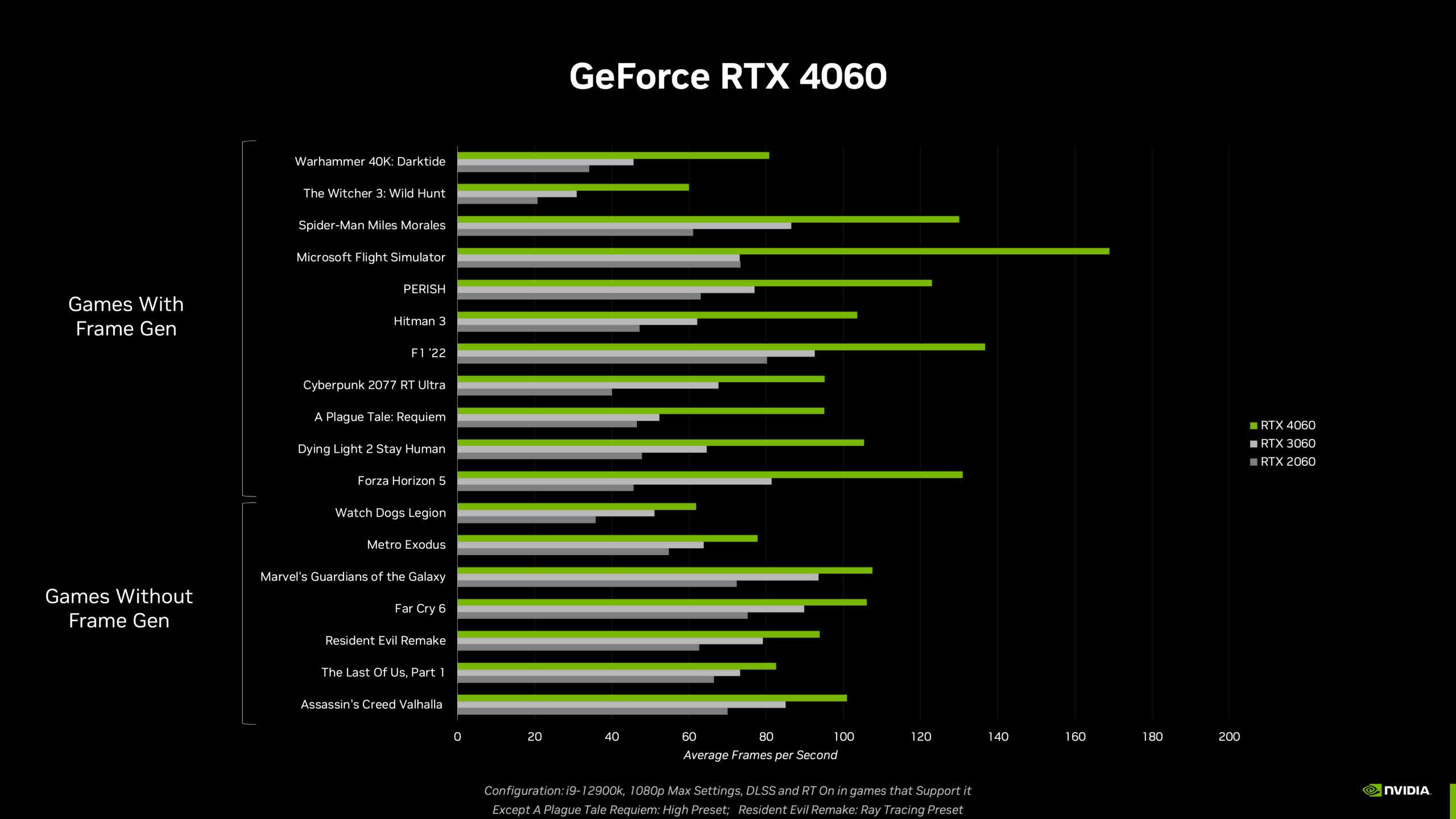
The RTX 4060's performance is listed by Nvidia as being 20% higher than the RTX 3060 and 60% higher than the RTX 2060, at a lower $300 price point. This is certainly a much more acceptable performance uplift, as the RTX 4060 is not only delivering a higher margin over its predecessor than the 4060 Ti but is doing so at a lower price, albeit with less VRAM. Based on our numbers, the RTX 4060 would therefore deliver performance that falls somewhat short of the RTX 3060 Ti, again at a $100 lower price.
Aside from the VRAM issues, Nvidia is facing strong competition from AMD in the lower parts of the market. The RTX 3060 at $330 wasn't hugely attractive when AMD was offering faster models like the Radeon 6600 XT for less than $330 for much of that card's life. Yes, the 6600 XT had a terrible launch MSRP of $380, but for the last 9 months, it's been priced below $300. Currently, this level of performance is available for around $260 – which would equate to the RTX 4060 offering roughly 15 to 20% more performance at a 15% higher price, if Nvidia's numbers are accurate relative to our previous testing. That's a much less exciting uplift, and it would require Nvidia's feature set to get it over the line – things like DLSS, AV1 encoding, and, judging by the TGP of this card, superior efficiency.
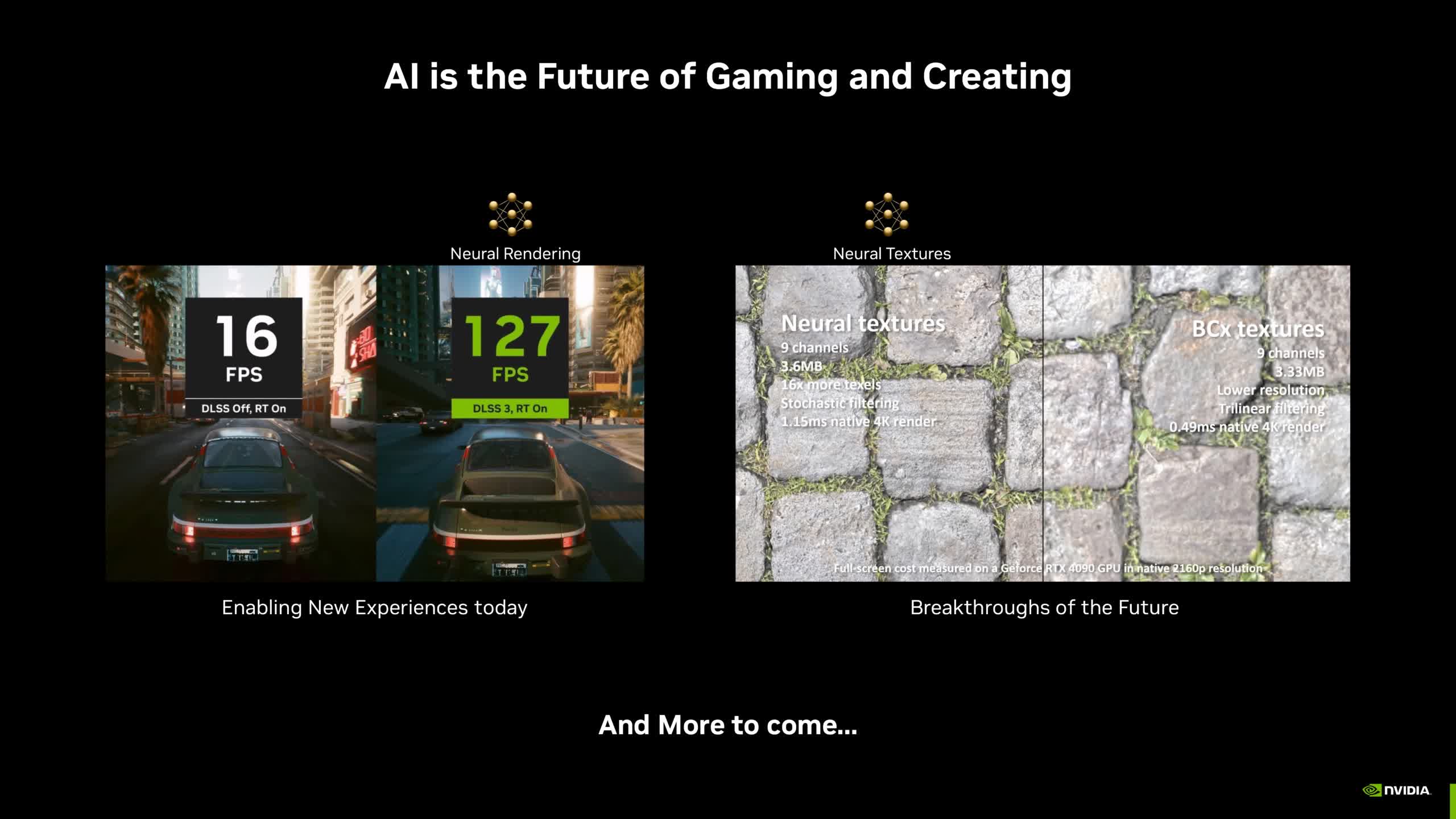
These are, of course, just first-party numbers, with many of the games listed being tested with DLSS 3 frame generation enabled – and we don't believe frame rates between DLSS 3 on configurations and DLSS 3 off configurations can be fairly tested in this manner. There's still a lot to play out here to see where actual performance lies, especially for games that may run into VRAM limitations and also titles that are heavy on memory bandwidth, given the reduction here compared to the Ampere generation.
All in all, it's good to see Nvidia launching products that don't have ludicrously increased prices at the same product tier, but upon deeper investigation, it appears that many of these products are compromised and may not provide excellent value to consumers.
The big issues are around VRAM capacity and performance uplift compared to the previous generation. In our opinion, $400 is too much to pay for an 8GB GPU in 2023, and even at $300, it's a difficult proposition – especially as the previous RTX 3060 actually has more VRAM. Nvidia's solution to this is getting you to spend $100 more for 16GB of VRAM in the 4060 Ti, which also feels like too much of a premium given the performance of the product. And speaking of performance, these cards appear to only have modest performance uplifts relative to Ampere; Nvidia's first-party performance figures certainly don't show mind-blowing gains, outside of frame generation comparisons.
It'll be fascinating to see where these cards end up after we test them. There's not much here pointing to a "must-buy" release and even less so considering that gamers aren't flocking out to buy GPUs right now. It's been surprising how low demand has been, for example, we didn't think the RTX 4070 was that bad, and it probably had one of the more positive reviews, but it seems GPU buyers have a different opinion. It's certainly an interesting time for the GPU market.
https://www.techspot.com/news/98731-nvidia-launches-three-new-geforce-rtx-4060-gpus.html
